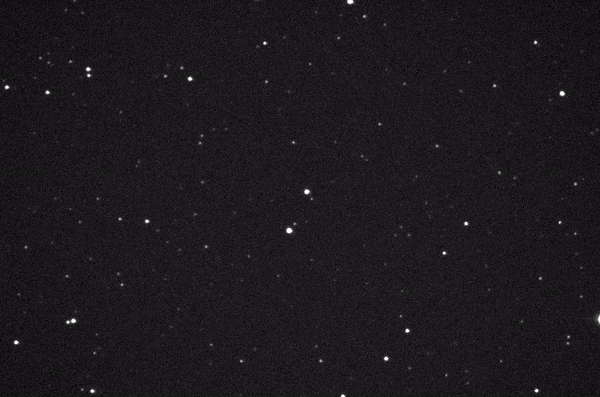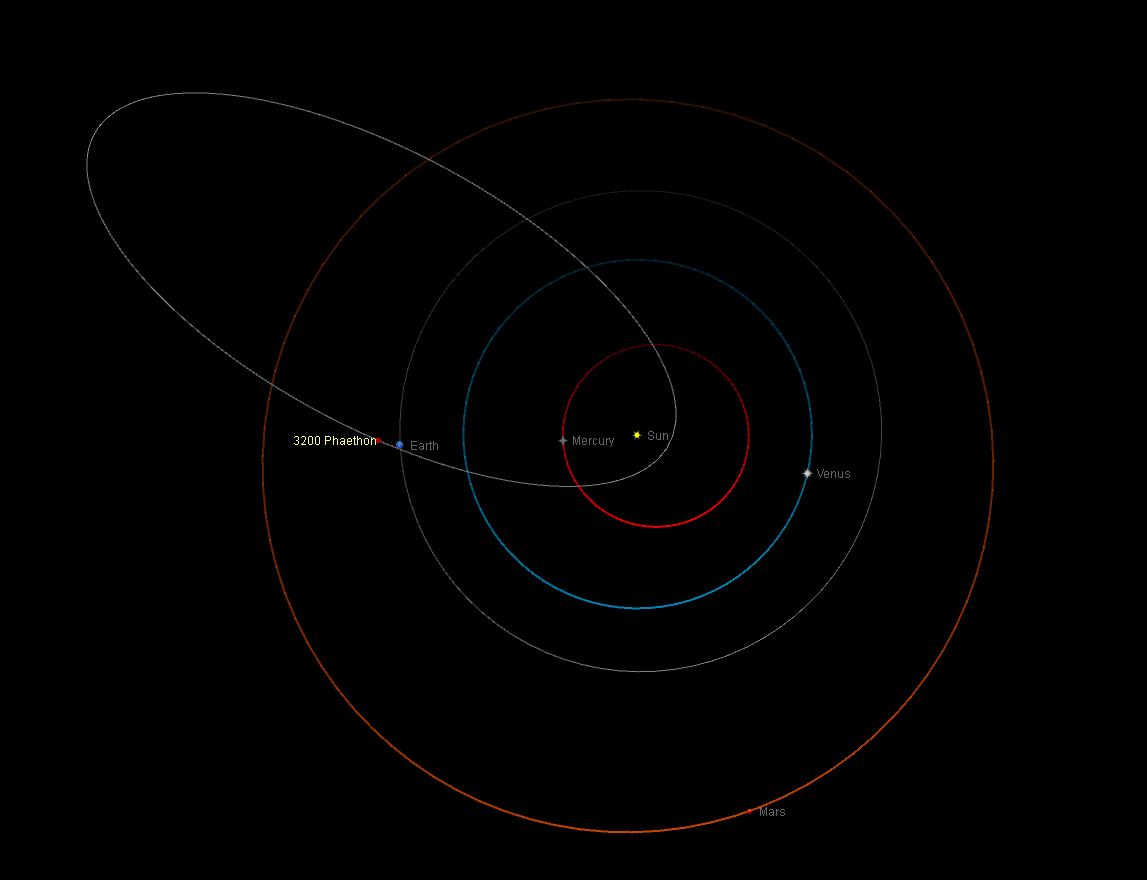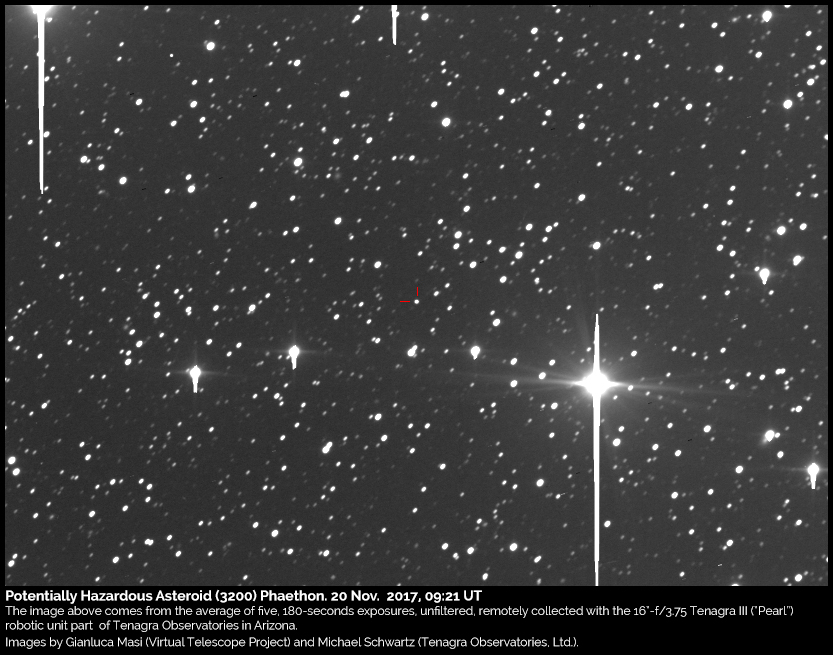Asteroid 3200 Phaethon, Likely Source of Geminid Meteor Shower, Flies by Earth This Week

Princeton astronomer Charles H. Young (1834-1908) used to tell his students that small asteroids were hardly more than "mountains broken loose," compared to the solar system's larger asteroids which are entire worlds unto themselves. This is probably an appropriate characterization of the asteroid 3200 Phaethon, which is an irregular chunk of rock about 3 miles (5 kilometers) wide — compared to the system's largest asteroids which can have diameters more than 100 times that. 3200 Phaethon would be a quite insignificant member of the solar system were it not for the object's remarkable orbit, which will carry it to within 6.4 million miles (10.3 million km) of Earth on Dec. 16.
Since the asteroid's discovery on Oct. 11, 1983, by NASA's Infrared Astronomical Satellite (IRAS), this pocket space rock — catalogued as 1983 TB — has gone around the sun nearly 24 times. It follows a 523-day ellipse that takes the object deep within Mercury's orbit during close approach to the sun and outside the orbit of Mars at furthest approach from the star. Phaethon is the third largest near-Earth asteroid classified as "potentially hazardous" by NASA, and as such, astronomers always keep a close watch on the rock's path when it closely approaches our planet. [December Lights: 6 Facts for the Geminid Meteor Shower]
We can also say that 3200 Phaethon may be "the mother of all Geminids." Meteor showers are created when the Earth flies through a path of debris left behind by a comet. 3200 Phaethon's orbit nearly coincides with the well-defined path of the Geminid meteor shower, suggesting that this asteroid might be the remnant of a comet that released a trail of debris behind it, creating the path that is now responsible for the annual shower. Interestingly, at the same time that the Geminids take center stage on Dec. 14, astronomers will also be concentrating on the object that may have given rise to the meteors a timeless interval ago.
A rare encounter
On its way toward the sun, this asteroid will skim past Earth, with the closest approach to the planet occurring on Dec. 16 at 5:59 p.m. EST (1059 GMT). At that moment, Phaethon will be 6,404,655 miles (10,307,293 km) from Earth — the equivalent of 26.8 times the distance from the Earth to the moon.
The Dec. 16 encounter is the closest approach to our planet by this asteroid since at least the object's discovery. Models of the rock's motion through space suggest that this is also the asteroid's closest approach to Earth since 1974, an encounter that also came on Dec. 16. Phaethon will not come that close to us again until Dec. 14, 2093, when it will skim past Earth at a distance of just 1.8 million miles (2.9 million km).
The asteroid will pass the perihelion point of its orbit (the point closest to the sun) on Jan. 25, 2018, at a distance of only 12.98 million miles (20.89 million km) from the sun. Because it can make such a close solar approach, Phaethon was named for the Greek mythological son of Helios (the sun god). In Greek mythology, Phaethon drove his father's chariot for one day, lost control of its horses and nearly set the Earth on fire.
Sighting opportunities
During a time span of nine days, Dec. 9 through 17, Phaethon will be brighter than visual magnitude +12.0, hence within convenient reach of a 6-inch (15 centimeters) telescope. (The dimmest objects visible with the naked eye are about magnitude +6.5.) Phaethon will appear at its brightest on the evening of Dec. 14, when the asteroid will attain a magnitude of +10.7. This date does not coincide with the time of closest approach two days later, because the phase angle — the amount of reflected sunlight striking the asteroid — will be greater on Dec. 14.
Breaking space news, the latest updates on rocket launches, skywatching events and more!
A magnitude of +10.7 places Phaethon just out of the reach of 7 x 50 binoculars, popularly known as "night glasses," but a 3-inch (7.6 cm) telescope, mounted on a sturdy tripod, should be able to do the job so long as you're located under a dark, clear sky. Thankfully, the moon will have left the evening sky and will not be a hindrance.
The apparent path of Phaethon among the stars goes far outside the regions traversed by ordinary asteroids. During the Dec. 9 through 17 time frame, the rock will move west through the constellations Auriga, Perseus, Andromeda, Pisces and Pegasus.
To locate Phaethon visually, you will need to use a star map on which the asteroid's track has been accurately plotted. For the more technically inclined, I have created a guide for finding the Phaethon in the sky, exclusively for Space.com readers, in the accompanying table.
The predicted positions listed for each date are for 9 p.m. EST (6 p.m. PST). The columns on the table are, in order: right ascension (R.A) and declination (Dec., 2000 coordinates); the constellation within whose boundaries the asteroid is located; distances from the sun (S dis) and Earth (E dis), in astronomical units (the mean distance from the center of the Earth to the center of the sun); and the visual magnitude.
| Dec. 9 | 5h 26.0m | +44° 49' | Auriga | 1.125 | 0.150 | +11.6 |
| Dec. 10 | 5h 03.9m | +45° 28' | Auriga | 1.110 | 0.134 | +11.3 |
| Dec. 11 | 4h 35.6m | +45° 53' | Perseus | 1.094 | 0.119 | +11.1 |
| Dec. 12 | 3h 59.4m | +45° 46' | Perseus | 1.079 | 0.106 | +10.9 |
| Dec. 13 | 3h 14.2m | +44° 34' | Perseus | 1.063 | 0.094 | +10.8 |
| Dec. 14 | 2h 21.1m | +41° 34' | Andromeda | 1.047 | 0.084 | +10.7 |
| Dec. 15 | 1h 24.6m | +36° 08' | Andromeda | 1.031 | 0.077 | +10.8 |
| Dec. 16 | 0h 31.0m | +28° 23' | Andromeda | 1.014 | 0.075 | +11.1 |
| Dec. 17 | 23h 45.1m | +19° 28' | Pegasus | 0.997 | 0.077 | +11.5 |
This faint, fleet object will be very difficult for most skywatchers to identify, except perhaps on the evening of Wednesday, Dec. 13, when the space rock will pass just one-half degree south of the orange, +3.8-magnitude star Kappa Persei at about 11:30 p.m. EST (0430 GMT on Dec. 14). You'll be able to make a positive identification if you keep watch of Kappa and note the presence of a tiny and very faint star below it (Phaethon will be only 1/630 as bright as Kappa).
What will set the asteroid apart from other objects in the sky will be its rapid motion; about one-half degree per hour (1 degree is equal to the apparent width of the full moon). Watching the asteroid move relative to the star will be like watching the minute hand of a wristwatch, but after 10 or 15 minutes you should be able to recognize that Phaethon has shifted its position relative to Kappa.
To be tracked by radar
The Goldstone Solar System Radar, or GSSR, is part of the Deep Space Network (DSN), a large radar system located in California's Mojave Desert some 180 miles (290 km) northeast of Los Angeles. It is utilized for investigating objects in the solar system. Phaethon is potentially detectable at Goldstone for about three weeks, and tracks are scheduled on 10 days from Dec.11 to 21. For more details about 3200 Phaethon, check this website.
Joe Rao serves as an instructor and guest lecturer at New York's Hayden Planetarium. He writes about astronomy for Natural History magazine, the Farmer's Almanac and other publications, and he is also an on-camera meteorologist for Verizon Fios1 News, based in Rye Brook, N.Y.

Joe Rao is Space.com's skywatching columnist, as well as a veteran meteorologist and eclipse chaser who also serves as an instructor and guest lecturer at New York's Hayden Planetarium. He writes about astronomy for Natural History magazine, Sky & Telescope and other publications. Joe is an 8-time Emmy-nominated meteorologist who served the Putnam Valley region of New York for over 21 years. You can find him on Twitter and YouTube tracking lunar and solar eclipses, meteor showers and more. To find out Joe's latest project, visit him on Twitter.



